
Hobby Boss 1/350 Type IXC U-Boat
| KIT #: | 83508 |
| PRICE: | 1800 yen (about $21.00) |
| DECALS: | Yes |
| REVIEWER: | Tom Cleaver |
| NOTES: | Includes photoetch |

| HISTORY |
The Type IX U‑boat was
designed in 1935-36 as a large, long range ocean‑going submarine. Type IX
U-boats were used during the winter and spring of 1942 for patrols off the
eastern
The Type IX-C was armed with
six torpedo tubes, four at the bow and two at the stern, with six internal
reloads and five external torpedo carriers, three at the stern and two at the
bow, giving a total load of 22 torpedoes. When used as mine‑layers, they carried
44
The Type IX-C U-boat was a
further development of the Type IX-B, with additional storage for 43 tons of
fuel oil, giving a range of 13,400 nautical miles at a cruising speed of 10
knots. 54 Type IX-C U-boats were
commissioned between 1939 and 1942.
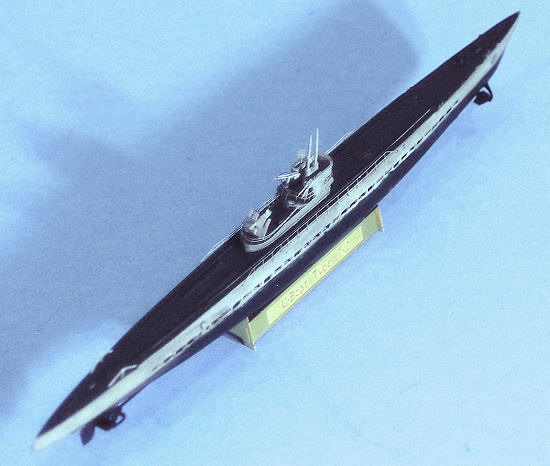 U-166, a Type
IX-C, was sunk by Sub-chaser PC-566 50 miles south of the
U-166, a Type
IX-C, was sunk by Sub-chaser PC-566 50 miles south of the
Type IX U-boats were
excellent sea boats, primarily due to their increased size.
They had sufficient range to allo their operation in distant waters such
as the South Atlantic, Indian and even the Pacific oceans, with several making
it to Japan on extended trips to deliver important cargo such as jet engines and
a complete Me-163, for the Japanese to use in their own design developments.
The Type IXs were the only U-boats that operated off of
The Capture of U-505:
The capture at sea of U-505
off the coast of
U‑505's keel was laid June
12, 1940, at the Deutsche Werft yards in
U-505's third and fourth
patrols in the summer and fall of 1942 took her into the
U-505's fifth through tenth
patrols in 1943 were all unsuccessful, with the U-boat returning after Allied
attacks in the
U-505 began her twelfth
patrol in May, 1943, assigned to patrol off
Enigma intercepts had
alerted the Allies that U-boats were operating off equatorial
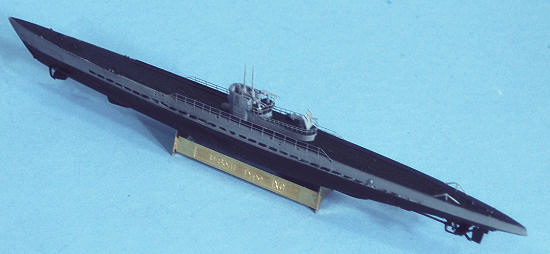 At 1109,
June 4, 1944 Pillsbury made sonar contact with U‑505 at 21°30"N 19°20"W,
about 150 miles off the coast of Río de Oro, 800 yards off the starboard bow of
Chatelain.
At 1109,
June 4, 1944 Pillsbury made sonar contact with U‑505 at 21°30"N 19°20"W,
about 150 miles off the coast of Río de Oro, 800 yards off the starboard bow of
Chatelain.
The Destroyer Escorts
immediately moved towards the position, while
Chatelain
was too close to U‑505 to use depth charges, and so opened fire with her
“hedgehog,” passing over U-505 then turning for a depth charged attack. At the
same time, one of the FM-2s sighted U‑505 and dived on the U-boat, firing into
the water to mark her position while Chatelain fired depth charges.
Immediately after the depth charge attack, a large oil slick spread on the water
and the fighter radioed, "You struck oil! Sub is surfacing!"
Less than seven minutes
after the first attack, a badly damaged U‑505 surfaced less than 700 yards from
Chatelain. The DE immediately
opened fire on U‑505 with all available automatic weapons, while the other ships
of the task group and the two Wildcats also attacked.
Wounded and believing U‑505
was seriously damaged, the captain
ordered the crew to abandon ship.
This order was obeyed so promptly that the scuttling was not completed and the
engines continued to operate. With engines still running and the rudder damaged
by depth charges, U‑505 circled clockwise at approximately 7 knots. Seeing the
U‑boat turning toward his ship and believing it was preparing to attack, the
captain of Chatelain ordered a torpedo fired, which missed, passing
ahead of the now‑abandoned U‑505.
Captain Gallery and his
captains had discussed the possibility of capturing a U-boat if it came to the
surface. With U-505 looking like
she might stay afloat long enough to make such an attempt, Galley gave the order
“Away all bparders!” and an 8-man team from the Pillsbury led by Lt (jg)
Albert David was launched while Chatelain and Jenks collected
survivors. Albert and the boarding party leaped from the whale boat onto the
after conning tower deck of U-505 (the U-boat was down by the stern, allowing
them to pass over the rear deck) and entered the U-boat, the first boarding of
an enemy vessel on the high seas by the
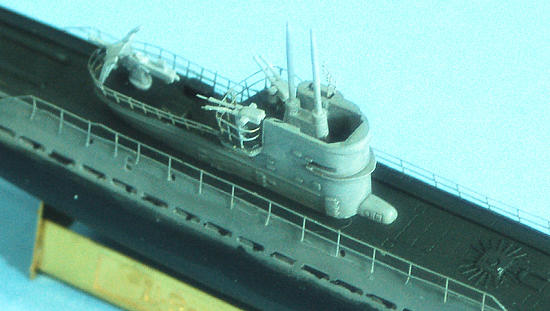
While the boarders secured
U‑505, Pillsbury made several attempts to take the U-boat in tow, but
collided with the submarine repeatedly and had to leave the area with three
flooded compartments. A second
boarding party from USS Guadalcanal managed to connect a towline, and
also disconnected U‑505's diesels from her motors, thus allowing the propellers
to turn the shafts while under tow.
As Guadalcanal towed the U‑505 at high speed, the propellers acted as electrical
generators, powering U‑505's pumps and air compressors to clear the flooding.
Towed by Guadalcanal across
the South Atlantic for three days,
U‑505 was transferred to the fleet tug USS Abnaki.
On Monday, June 19, 1944, U-505 entered Port Royal Bay, Bermuda, after a
tow of 1,700 miles, the first enemy vessel captured by the U.S. Navy since 1814.
58 prisoners, including three wounded, were rescued. Because it was crucial that
the Germans not discover that U-505 with all her code books had been captured,
the crew was interned separately from other POWs at Camp Ruston, near Ruston,
Louisiana, where they were held incommunicado from the Red Cross until March
1945. The Kriegsmarine had declared them dead and so notified their families in
November 1944.
The guards at Camp Ruston
included members of the U.S. Navy baseball team, composed mostly of minor league
professional baseball players, who had previously toured combat areas to
entertain the troops. During their imprisonment, the Navy players taught some of
the U‑505 sailors to play the game.
This story is told in “Playing with the Enemy: A Baseball Prodigy, a World at
War, and a Field of Broken Dreams,” by Gary Moore.
The Enigma secret was so
important that Admiral King, the Chief of Naval Operations, at first considered
a court-martial of Captain Gallery for endangering the secret by capturing
U-505. King relented, and Lt.(jg)
David became the only USN sailor in the Atlantic Theater of Operations to win
the Medal of Honor for leading the boarding party, while TM3 Arthur W. Knispel
and RM2 Stanley E. Wdowiak were each awarded the Navy Cross and S1/c James
Beaver was Silver Star.
Commander Trosino, captain of the Pillsbury, received the Legion of
Merit.
The captured code books were
of crucial importance. These
arrived at Bletchley Park on June 20, 1944.
They included details of the special "coordinate" code in enciphered
German messages, which allowed a determination of more precise locations for
U‑boat operating areas, allowing hunter-killer groups to be directed there while
convoys could be routed away. Other
material included the regular and Offizier
Enigma rotor settings for June 1944, the current short weather codebook,
and the short signal codebook - which allowed further decoding of intercepted
messages - as
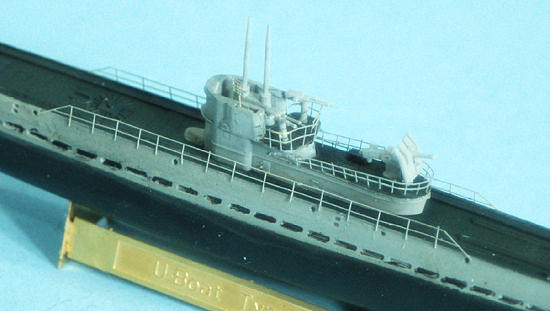 well as the
bigram tables due to come into effect in July and August respectively.
Using this information, the U-boat menace in the Atlantic was virtually
ended by the end of the summer of 1944.
well as the
bigram tables due to come into effect in July and August respectively.
Using this information, the U-boat menace in the Atlantic was virtually
ended by the end of the summer of 1944.
During World War II, 1,162
German U‑boats were built. Between
1939-45, 790 of them - 80 % - were sunk by enemy action.
In 1947, the Navy planned to use U-505 as a gunnery target. An appeal was made and the submarine was given to the Chicago Museum of Science and Industry, where it has been displayed since 1950. In 2000, after 50 years out in the open during Lake Michigan winters, the U-505 was in sad shape. Another campaign was mounted to save her, and she is now completely overhauled and displayed within a closed structure that protects her from the elements. U-505 is one of four Type IX submarines still in existence. I saw her 40 some years ago, and was impressed (after being inside US Fleet submarines) at how small and tight she was. U-505 is an impressive display and you should plan to visit if you are ever in Chicago.
| THE KIT |
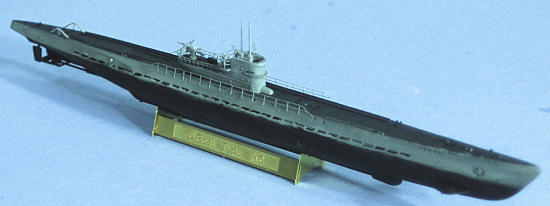 Hobby Boss
has now completed the only set of Type IX U-boats in 1/350 scale, having
previously released a Type IXA and a Type IXB.
This Type IXC is the early version, which could be easily modified to the
late war production standard IXC/41, with the schnorkel mast.
The kit is amazingly well-detailed for such a small model (6 inches
long). The surface detail on the
main deck is astounding, with the two conning tower decks being done in photo
etch brass, which allows all that deck detail.
The weapons include the 105mm main deck gun, the two twin 20mm mounts,
and the Flak-37 mounted on the “winter garden” deck.
These are superbly rendered in very petite moldings.
The splinter shield for the Flak-37 is done in both plastic and photo
etch brass, and the plastic shield is excellent.
Hobby Boss
has now completed the only set of Type IX U-boats in 1/350 scale, having
previously released a Type IXA and a Type IXB.
This Type IXC is the early version, which could be easily modified to the
late war production standard IXC/41, with the schnorkel mast.
The kit is amazingly well-detailed for such a small model (6 inches
long). The surface detail on the
main deck is astounding, with the two conning tower decks being done in photo
etch brass, which allows all that deck detail.
The weapons include the 105mm main deck gun, the two twin 20mm mounts,
and the Flak-37 mounted on the “winter garden” deck.
These are superbly rendered in very petite moldings.
The splinter shield for the Flak-37 is done in both plastic and photo
etch brass, and the plastic shield is excellent.
| CONSTRUCTION |
Construction is
extremely simple, but care must be taken with all the extremely-delicate
small parts. Assembly takes
perhaps an hour total.
Everything should be attached other than the conning tower and the weapons
and the photo etch railings before painting.
| COLORS & MARKINGS |
I painted the model with Tamiya Light Grey XF-66. This was masked and the hull was painted with Tamiya “NATO Black.” I did the main deck and the conning tower decks with lightened “NATO Black.” I applied a thinned coat of Tamiya “Smoke” to pop out detail in the light grey areas and to give a simulation of weathering.
| FINAL CONSTRUCTION |
| CONCLUSIONS |
 I wish
Revell would do a Type IX series in 1/144, which I think is the perfect scale
for submarines. However, this 1/350
kit is very nice, and has some of the best detail I have seen in a submarine
model. Placing it next to other
1/350 ships, one sees immediately how small these boats were, which adds to the
respect one can have for the men who went down to the sea - and down in the sea
forever - in these ships.
I wish
Revell would do a Type IX series in 1/144, which I think is the perfect scale
for submarines. However, this 1/350
kit is very nice, and has some of the best detail I have seen in a submarine
model. Placing it next to other
1/350 ships, one sees immediately how small these boats were, which adds to the
respect one can have for the men who went down to the sea - and down in the sea
forever - in these ships.
Review kit courtesy of HLJ.
Get yours at www.hlj.com
If you would like your product reviewed fairly and quickly, please contact me or see other details in the Note to Contributors.